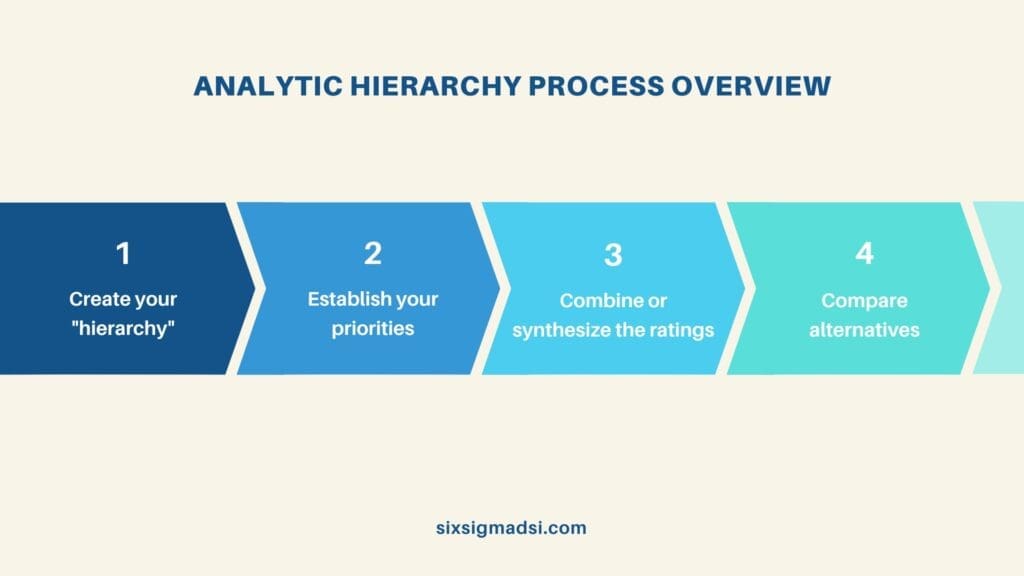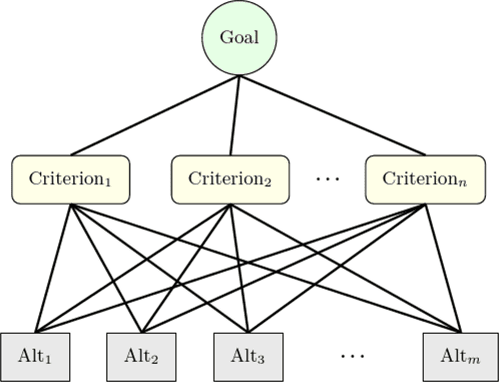Table of contents
What Is an Analytical Hierarchy Process?
The Analytic Hierarchy Process is a method that uses math and psychology to organize and analyze complex decisions in hierarcy. Thomas L. Saaty developed it in the 1970s, and since then has refined it. The three main parts of AHP are the goal you want to achieve or the problem you need to solve, the alternative solutions you can choose from, and the criteria that you will use to evaluate the options. AHP is a framework that helps you make a decision rationally by quantifying the criteria, evaluating alternative options, and comparing them to your overall goal.
Through pair-wise comparisons, stakeholders compare the relative importance of two criteria. For example, are you more concerned about the job benefits, or a shorter commute, and how much? AHP converts the evaluations to numbers that can be compared with all possible criteria. AHP’s ability to quantify sets it apart from other decision-making techniques.
The final step in the process involves calculating numerical priorities for each alternative option. These numbers are the most desirable solutions based on user values.
Analytic Hierarchy Process Overview

Here is a brief overview of the Analytic Hierarchy Process.
1. Create your “hierarchy” “
- Identify your goals or objectives.
- Identify your choices.
- List the main factors that you will use to compare each option.
- Link these to the major factors. Connect these to major factors
- Continue building a hierarchy of criteria for decision-making until all factors have been identified and linked.
2. Establish your priorities.
- Determine your preference for criteria using paired comparison (for example, A may be slightly more preferred over B, or B may be much more preferred over C).
- Please rate these preferences between 1 and 9.
- Repeat the process for each level of your hierarchy. This will be made clearer by the example below.
3. Combine or synthesize the ratings.
- Calculate a weighted criterion score that combines all the ranking data.
4. Compare alternatives
- Calculate a final score using the combined scores for each option.
3 Benefits of the Analytical Hierarchy Process
AHP is a structured method that combines group decision-making with quantitative evaluation. This provides a better approach than flipping a penny or relying on a purely subjective approach.
1. Forces of choice
People often claim that all choices are equally important when asked to choose between them. You can prioritize your choices by forcing you to choose between two comparisons.
2. Group decision making
A group can provide a more comprehensive and broader perspective than an individual.
3. Simple Calculations
Prioritization calculations are easy, especially if the matrix is set up in an Excel spreadsheet.
Why is it Important to Understand?
It is more effective to choose alternatives systematically than by guessing. It is essential to understand how AHP works in order to use this simple but powerful technique.
It is especially useful for complex problems that have high stakes. It is different from other decision-making techniques because it quantifies options and criteria that are traditionally difficult to quantify with hard numbers. AHP does not prescribe a single “correct” solution but helps the decision maker find one that suits their values and understanding of the problem.
It is important to have all stakeholders weigh in, since different divisions value criteria differently. When deciding on a new piece of software, for example, Sales might be more concerned with its ease of use, while Admins may care more about the integration into other systems. AHP differs from a poll or meeting in that it removes bias from the decision. Using the AHP also boosts morale, as everyone feels heard and can understand how decisions are made.
The decision is not correct
AHP’s value is in consolidating the understanding and perspective of a group. The decision is then optimal for the group and not necessarily correct or best.
This is useful when quantitative data are not available.
You can use hypothesis tests, Regression, or Design Experiments to choose between alternatives if you have quantitative data. AHP can be used when this type of data isn’t readily available.
3 Best Practices for AHP
AHP is relatively easy to use, but there are some things you should consider in order to get the best results.
1. Choose a reasonable scale
You can use the same scales as above, but you may also want to consider a 1-5 scale, a 1-10 scale, or even a simple 1,3,9 scale.
2. Select only one or two criteria to evaluate.
It is not a good idea to have too many options. This is especially true if the options are similar. The options should be sufficiently different, otherwise, the group might have trouble deciding between them.
3. Choose a method by which to consolidate group evaluations
Different people will have different opinions about the relative importance and magnitude of each criterion. The team should decide on how to combine all the different opinions and come up with a consensus.

Tips for Analytical Hierarchy Process
Tip #1:
This approach may sound familiar if you are familiar with paired comparison analysis. AHP’s power is that it uses the paired comparison method to determine relative weights for various criteria. It then transfers these weights across all levels of criteria in order to calculate overall weightings. You can then calculate an objective score per alternative.
Tip #2:
This is a complex approach that requires careful calculation and thought. Use it only if Paired Comparison Analysis doesn’t give you the answers you need, or if the problem is complex, significant, and involves multiple subjective factors.
Combining Qualitative and Quantitative
We are rational creatures and we like to measure variables to arrive at objective decisions. The problem is not all criteria can be easily measured.
Thomas Saaty developed the Analytic Hierarcy Process in the 1970s to address this problem. This system is helpful because it combines the “black-and-white” of mathematics with the subjectivity of psychology to make easy-to-justify decisions.
Let’s take a (perhaps a little trivial) example. The decision-making process for determining the best morning route is simple and straightforward. After a week of using each alternate route, you would time your commute and then choose the fastest one on average.
The decision becomes more complicated if you decide to carpool with others and have to take into account everyone’s preferences. Larry is worried about his safety because one route passes through a dangerous area of the city. Joanne wants everyone to be able to get coffee by stopping at a drive-through coffee shop. Richard says that Java Jolt has better coffee than Cuppa Jo. Both types of coffee are available in different locations throughout the city.
You’ll need to consider both quantitative and qualitative factors, as well as tangible and intangible ones. You also need to take into account the perspectives and priorities of different people.
The analytical Hierarcy Process can combine all of these factors into a standard numerical scale. This will allow you to make a decision objectively while considering all of the criteria.
Have you implemented the Analytical Hierarchy Process?
Tell us about your experience in the comments below!



















